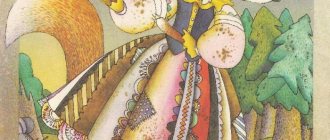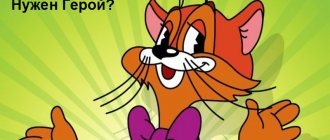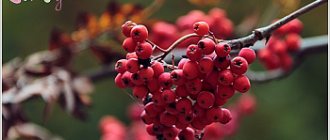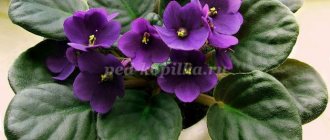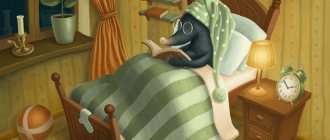A fairy tale about indoor plants for preschoolers
Fairy tale for children 5-7 years old
Educational fairy tale for preschool children “Green Hedgehog”
Author: Natalya Mikhailovna Golyshevskaya, senior teacher of MBDOU “Kindergarten No. 12” in Barnaul Purpose: this material is intended for preschool children Purpose: to expand preschoolers’ ideas about indoor plants Objectives: - to introduce children with features of appearance, structure, growing conditions of indoor plants; — teach how to perform labor actions to care for indoor plants; - develop curiosity, cognitive interest. Once upon a time there lived a Little Cactus. It was round, green and prickly. That's why they called him the Green Hedgehog. But he was prickly only on the outside, but in fact, the Cactus Child was very kind and sympathetic.
Recently, the owner separated him from his mother Cactus and planted him in a beautiful small pot. The little cactus liked his new house, but one thing upset him: plants unknown to him grew around him in large flower pots. But Little Cactus was sociable and inquisitive. He decided to get to know his “neighbors” better, because the Green Hedgehog so wanted to have friends! The first person the Cactus Kid dared to talk to was a plant with a thick, woody trunk, the round leaves of which looked like coins.
“Excuse me, please,” said the Green Hedgehog, a little embarrassed, “what is your name?” “People call me the money tree, people believe that I bring wealth and prosperity to the house, but scientifically I am called the tree crassula,” answered the tree. My homeland is the African savannah, so I love the sun. I also love it when my pot is turned from time to time, then I grow into a slender and beautiful tree. - Tell me, aren’t you bored of standing on the windowsill all the time? - asked Cactus. - No, of course, in winter I can watch what is happening outside the window, and in the warm season they send me “to the dacha,” that is, they take me out into the fresh air - onto the balcony. Here another plant with unusually beautiful leaves, on which bright red veins and spots stood out, intervened in the conversation: “And my name is arrowroot, I really love humidity and am afraid of direct sunlight, so I like it when the owner sprays my leaves with lukewarm water.” And I can also pick up leaves and fold them at dusk and even a few hours before rain, like a real barometer.
The little cactus listened very carefully to the stories of the plants, because he was still small and did not know much. An unusual plant grew in one of the pots; its dark green sword-shaped leaves with a pointed apex and light transverse stripes resembled fish scales. It turned out that this is a sansevieria, which is simply called “pike tail”. The little cactus even felt a little funny when he heard this name.
Suddenly the door opened and the hostess entered the room. In her hands was a pot with a very beautiful plant. “Meet this, this is your new neighbor,” she said (the owner often talked to her pets, because she believed that flowers, like living beings, understand everything and love when you communicate with them) “this is a fern. It will not only decorate the room, but also help clean the air from dust and harmful substances. It’s just a pity that the ferns don’t bloom, but they delight you with their varied leaves: huge, tiny and even curly.
The hostess put the pot down and left. So a “newbie” appeared on the windowsill. He quickly got used to the new environment and proudly talked about the fact that ferns are the oldest inhabitants of the Earth, existed along with dinosaurs and have survived to this day. So the Green Hedgehog not only met his “neighbors”, but also learned a lot of interesting and useful things.
We recommend watching:
For preschoolers about the seasons. A fairy tale about how Winter got lost. Summary of the GCD in the preparatory group on the topic “Getting to know the emotions.” A fairy tale for preschoolers. Shishkinsky Ponds Ecological fairy tale for children 6-9 years old
Similar articles:
A fairy tale about kindness for older preschoolers
Developing interest in folk art through familiarization with Russian folk tales in children of primary preschool age
read fairy tales about flowers
It's time to sleep
The last fairy tale from Alyonushka's fairy tale series tells about a wonderful world where a girl goes in her dreams. There she will meet talking flowers, travel to distant lands, fly on a ladybug and even meet Grandfather...
Snail and rose
Hans Christ. Andersen
Andersen's fairy tale about a beautiful rose bush, which was fragrant with flowers every year, enjoying every day, and about a snail living under the bush and spitting on the world around... The snail and the rose read Around the garden there was a hedge of...
Violet at the North Pole
A short tale about a violet that found itself alone in the ice. The animals marveled at the unusual phenomenon for them. And the violet decided to melt all the ice alone, but she did not have enough strength... Violet at the North Pole read One morning...
Five from one pod
Hans Christ. Andersen
The fairy tale tells about five peas that lived in one pod until a boy picked them. They all ended up in different places. And their fates ended differently. The story of the fifth pea, which fell into the crack under...
Little Ida's flowers
Hans Christ. Andersen
One day she asked a student why her flowers were wilting. He told her a wonderful story about flower balls. That same night, Ida woke up and saw a beautiful flower ball, to which even dolls came... Little flowers...
Nightingale and rose
The Nightingale and the Rose is a sad story about love and self-sacrifice, about cold calculation and true service to beauty. The little nightingale decides to help the Student get the love of a girl. To do this, he will have to sing all night with a thorn in...
STORIES ABOUT MEADOW AND WILD FLOWERS IN PICTURES FOR CHILDREN
GERANIUM MEADOW
Geranium grows not only at home on the windowsill. It also grows in the meadow. Geranium that grows in a meadow is called... what do you think? If it grows in meadows, what is it like? Meadow. This is a meadow geranium. What color are the flowers of indoor geraniums in our home? And the flowers of meadow geranium (bluish-purple). How does our indoor fragrant geranium differ from meadow geranium? Meadow geranium blooms very little - only two days! But it has a lot of flowers, which is why it seems to us that geranium blooms for a long, long time.
Meadow geranium flower with five petals. The edges of the petal are rounded and smooth. Several stems arise from one root.
Geranium pollen is loved by various insects and crawling bugs. But geranium is an amazing flower. She does not give her pollen to bugs, but saves it for bees and butterflies. How does she protect herself from bugs? How do you think? Let the child come up with his own version and try to find the answer to this question. It turns out that the stem near the geranium flower is covered with a sticky liquid. And bugs simply cannot crawl through it. But this does not bother butterflies and bees. Why? Let the child find the answer to this question and make an assumption. Even if he didn’t guess correctly, reward him for not being afraid to think and express his opinion. That's right, because bees and butterflies fly and land on top of the flower! And this sticky liquid on the stem at the bottom of the flower does not bother them at all. If the child does not understand, then cut out the silhouette of a butterfly from paper and show how it sits on the palm of a flower. It does not crawl along the stem, but sits on top and does not touch this sticky substance.
Another name for geranium is crane grass. What word does it look like? That's right, in the word crane, crane. How is geranium similar to crane? Look at the geranium fruits. They appear closer to autumn, when the geranium has faded. What does this fruit look like? Yes, the fruit has a long beak, like a crane. That is why meadow geranium is also called cranebird. As soon as such a fruit with a beak in a meadow geranium ripens, the seeds will fall out of it. Where they fall, new meadow geranium plants will grow next year
Geranium is a medicinal plant. Meadow geranium paste was applied to snake bites, changing it every 10 minutes, and it greatly helped both people and animals.
DANDELION
All children and adults know dandelion. And they know its peculiarity - this flower is first yellow, and then white with many parachutes with seeds.
Wears a dandelion yellow sundress. When he grows up, he will dress up in a little white dress. Light, airy, obedient to the wind (E. Serova).
Why are dandelions called “a little portrait of the sun” in the poem? What would you call them? They are yellow like... (like what?)
Did you know that dandelion can predict the weather? Can you guess how he does it? How can he tell us that it will rain soon? The dandelion cannot speak like a person, but it speaks to us in its own way: it closes its petals and lowers its head. And if the dandelion is already white, then before the rain it folds its parachutes - it hides from future rain. And he tells you and me: it will start raining soon.
Dandelion is a very useful plant:
- They make jam from dandelion! Yes, the real thing, similar to honey. This is why it is called “dandelion honey.” But for such jam you need to collect flowers very far from the city and from roads. How do you think why?
- Dandelion roots are dug up in the fall and used to treat various diseases. After all, dandelion is a medicinal plant; people have been treated with it since ancient times.
- Salads are made from young dandelion leaves. But so that the leaves are not bitter, they are first kept for half an hour in salt water. What a dandelion!
BELL
Bells grow both in the meadow and in the forest clearing. They are very beautiful - blue and purple. There are single flowers on a bell, and there are whole bouquets.
Bell - blue color You tell us your secret, Why don’t you ring, Even though you move your head, Sometimes you bend from the wind, Sometimes you hide from the sun (N. Sergeeva).
The bell can also tell us about the weather. Surely your baby has already guessed how the bell speaks to us and how to “read” the language of flowers? Yes, in cloudy weather and at night the bell closes, that is, lowers its head - it hides
And small bugs, spiders and flies hide in it, like in a house. They feel warm and comfortable there, just like in a little house.
Here is such a bell - a teremok. Various small insects love him for this!
Try with your child to compose a fairy tale “The bell is a tower” or “Under the bell” about how during the rain, under the bell, various insects hid and got to know each other (by analogy with Suteev’s fairy tale “Under the mushroom”). It is best to act out such a fairy tale in pictures or with toys. In this fairy tale, you will be able to consolidate your child’s ideas about insects and stimulate dialogical speech. Start the fairy tale yourself, and the baby will continue the sentences you started: “There is a little house in the meadow. He is not short, not tall, not tall. That teremok is called a bell. One time... She ran up to the bell... And she said... And the bell answered her.... And she began... to hide from the rain in the bell” and so on. By starting phrases, you help your child learn how to structure a text and how to connect sentences in a text. Be sure to write down the resulting fairy tale and retell it - the child needs to feel that his achievements in writing and speech creativity are significant for close adults!
CHAMOMILE
Everyone also knows chamomile and will never confuse it with other flowers. Although no! They're confused! If you see one large flower on one stem, then it is not a chamomile, it is a chamomile. And chamomile has a strongly branching stem. And on one chamomile plant there are always a lot of small flowers. Chamomile is called medicinal chamomile because it helps against many diseases.
TANSY
Tansy is very easy to recognize. She has flowers like yellow buttons, collected in a cluster. What do its flowers look like? Listen to the poem. What did the poetess compare tansy flowers to? Isn't it true that she came up with an interesting idea?
Even if tansy is modest, it’s still medicinal, It’s not for nothing that the flowers look like pills, They also look like chickens, bright yellow for now, To the touch they look like a puppy’s suede nose (T. Golikova).
Look carefully at two pictures - tansy and rowan. How are tansy and rowan similar? What is the difference? Why do you think tansy is called “wild mountain ash”? (Tansy leaves look like rowan leaves. And the clusters of yellow flowers look like rowan clusters. So they called it “wild rowan”)
Tansy is a special flower. It is medicinal, i.e. used for treatment. And this is a real compass. Yes, if you don’t have a compass, tansy will replace it! Tansy has a secret. The edges of tansy leaves are always directed from north to south!
Green dye is made from tansy - it is used to dye threads and fabrics. Tansy also repels insects. She has a very unpleasant smell. The housewife will pick the tansy, bring it home, hang it on the wall, and all the insects will fly away. They don't like the smell of tansy.
Previously, cooks collected tansy leaves and put a little of its leaves in gingerbread and cookies for flavor. They say that the gingerbreads turned out delicious!
FORGET ME NOT
They are visible and invisible, you can’t count them! And who just invented them - Cheerful, blue ones? They must have torn a piece from the sky, done a little magic and made a flower. Author: E. Serova
Forget-me-not blooms for a very long time, almost until autumn. There are many of them on the banks of streams. Forget-me-not petals are blue. What else is blue in summer? Yes, the sky is blue, the stream and river are also blue. And in the middle of the forget-me-not there is a tiny yellow center, like a little sun. It’s as if she’s telling us: “Don’t forget.” There are many legends about this flower, but for the most part these are legends for adults, not for children.
CHICORY
If you see chicory flowers, it means it’s the tip of summer! Heat! Chicory is very strong, even drought is not scary for it! It has round blue flowers - baskets. And the stem is silvery and sticks out high up.
Why is chicory easily confused with cornflower? How are they similar? How can their flowers be distinguished?
Chicory is a medicinal plant. To treat various diseases, its branches are brewed, salads are made from the leaves, and a drink is made from the roots that replaces coffee. Show your child chicory in the store. And if you drink this drink and you have it at home, then let it taste.
Chicory wakes up very early - at dawn, when many other flowers are still sleeping. And he falls asleep in the afternoon. If the chicory flowers do not open in the morning, it means it will rain.
Cornflowers
Riddle about the cornflower: The head is blue and the stem is long. Well, who doesn’t know him! This is... (cornflower)
If you go to a field in summer, you will see a lot of cornflowers. Cornflowers have a very beautiful petal shape - with jagged edges. And the head of the flower seems to lie on a green cone.
What boy's name is the name of this flower similar to? Vasily - Vasya-Vasilek.
PLANTAIN
Plantain is a traveler's friend. How do you think he helps him? If you pick plantain leaves, wash them and put them on the wound, they will help the wound heal faster. This is the kind of doctor the plantain is. Why did they call him that - plantain? Road worker. On the way to. Because it grows along the roads. And it's very easy to find! Not only plantain helps travelers and heals their wounds. Travelers also help him. How?
They carry plantain seeds. Of course, not in a bag like in a seed store. They carry seeds on the soles of their shoes. Plantain seeds are very small, easily stick and travel on shoes. And when they fall to the ground, a new plantain grows here.
And the plantain is not afraid of us when we walk on it - its leaves are elastic, pressed tightly to the ground, and it is not afraid of trampling like other delicate flowers. But if its leaves were not pressed to the ground, but were raised above it, then it would be afraid of us! After all, leaves raised above the ground are very easy to break and trample.
WE PROTECT MEADOW AND WILD FLOWERS!
Explain to your child how important it is to protect meadow and wildflowers and not pick them in vain. If you pick them, they will quickly wither and still will not bring joy. And in a field or meadow these flowers will delight everyone for a long time, and next year new flowers will grow in the same place. Because people pick flowers, many types of flowers began to disappear.
The rarest flowers are included in a special Red Book. And they were forbidden to tear them and collect them.
Previously, when people went to collect medicinal herbs, they took only those herbs that they needed and asked the Earth:
“Mother, native land, I know: you are generous. Let me take the grass home and find health."
Flowers also suffer from trampling. Therefore, it is better to walk in the forest along or near paths.
Let's preserve the beauty of nature together!
Teacher of the 1st quarter category Olga Viktorovna Chernikova
